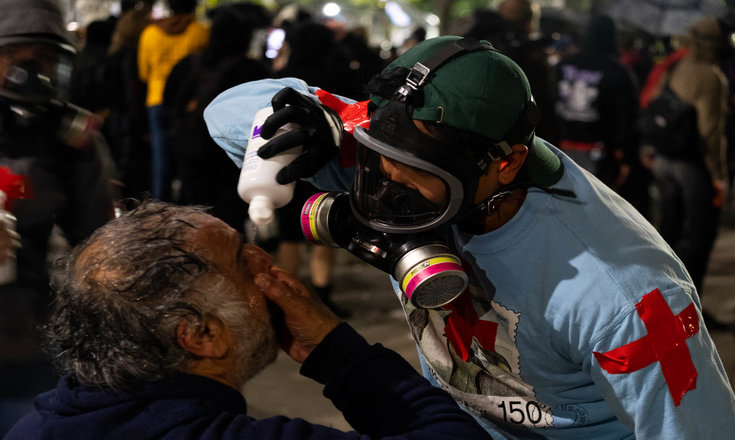The words “tear gas” have been thrown around innumerable times since the beginning of the popular uprising in response to the police killing of George Floyd. It has become one of the most prevalent and controversial police tactics for dispersing crowds of protestors. What tear gas is is not entirely clear by watching news footage. What does it do to our bodies? And how are the effects treated?
Tear gas is a bio-hazardous chemical weapon that causes severe pain, bleeding, irritation and, in the long term, respiratory illness and blindness. It does this by overstimulating the lacrimal gland to produce tears and irritates the membranes in your eyes, nose and mouth. It’s not a gas at all, but an aerosolized solid or powder that is released with compressed air.
Cousins of this chemical weapon were used in large doses during WWI, which later spurred the Geneva Protocol of 1925, an international multilateral war and arms treaty. The treaty bans use of “asphyxiating gas, or any other kind of gas, liquids, substances or similar materials” in warfare, but use of tear gas is not banned for purposes of protest management and riot control, hence the police use of tear gas canisters. As with any “non-lethal” weapon, there are always major risks. People with pre-existing asthma or other respiratory conditions are at particularly high risk of permanent damage or death. Chemical burns, permanent blindness and asphyxiation are all severe effects of tear gas. The physical canisters themselves are shot at a velocity strong enough to cause severe damage to bone.
Protestors can take a lot of routes to combat the effects of tear gas, from swim goggles to adapted water bottles to scuba goggles to covering limbs with cling film or heat proof gloves. Flushing with water or saline solution is usually the best immediate response, contrary to the popular suggestion of using milk.
Milk is not something you want to put in your eyes, as it really has no benefits differing from water and comes with way more risks. Experts like Sven-Eric Jordt, Ph.D., an associate professor of anesthesiology at Duke University, have concluded that milk carries the risk of bacterial growth, infection, inflammation and contamination. Even though milk is known to combat the effects of capsaicin in food, it functions differently on skin, and water is always the better option. Jordt instructs to “use plenty of water to rinse your face and eyes,” as it will be much safer than milk in the long run, though it might not provide the same immediate relief from the pain and irritation.
In general, water or an alkaline solution such as saline is what you want to reach for, as it counteracts the effects of tear gas and doesn’t leave you as open to infection later. Washing clothes and other affected personal items is important also, as the particles can stick and cause irritation later. It is most important for slowing the effects of tear gas to get away from the source of the gas and into clear air if possible, while rinsing immediately and using soap to remove particles later.
For more information on what to do if you or someone else is exposed to tear gas, check out this tear gas guide from Popular Science.







Be First to Comment